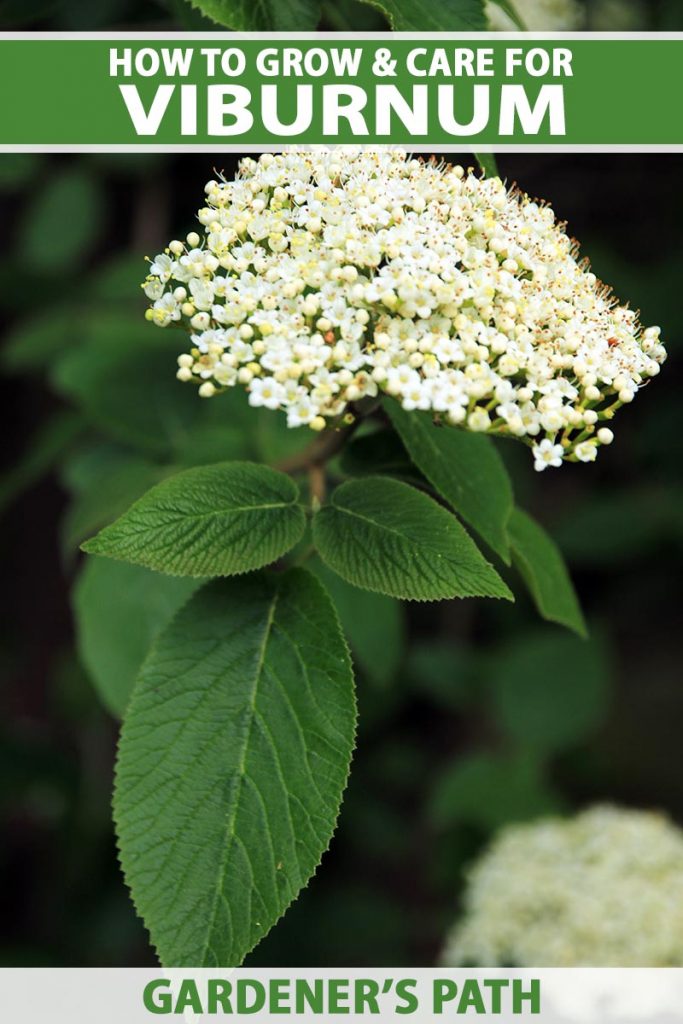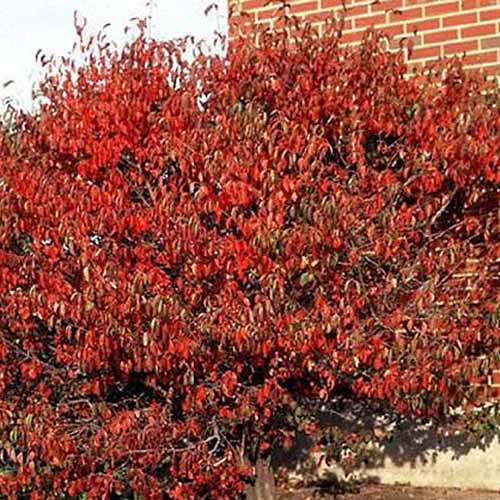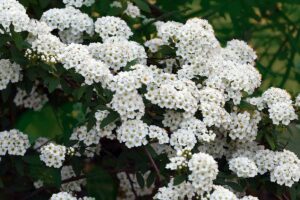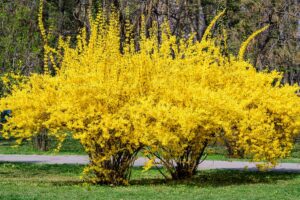Viburnum spp.
The Viburnum genus contains more than 150 different ornamental woody shrub species. These are members of the Adoxaceae family, which also includes elderberries.
There are species suited to cultivation in USDA Hardiness Zones ranging from 2 to 8.
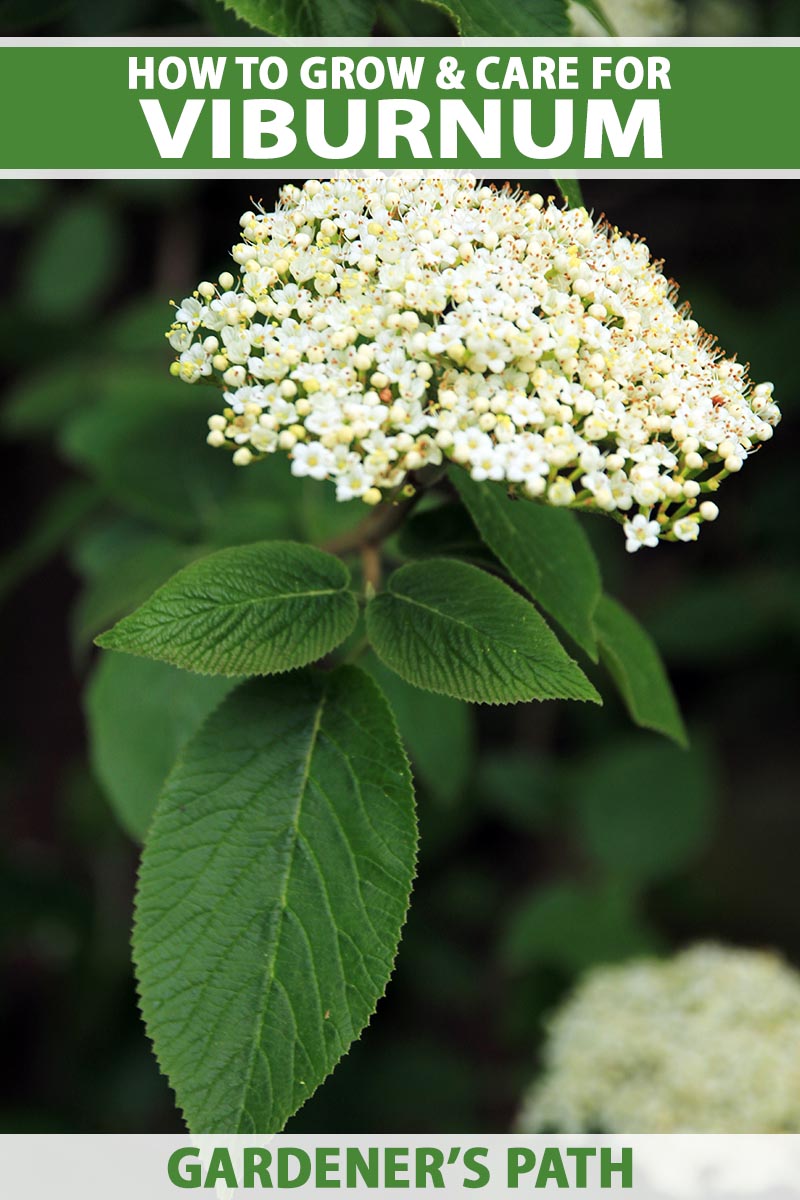
We link to vendors to help you find relevant products. If you buy from one of our links, we may earn a commission.
There are native and non-native species with either a deciduous or evergreen growth habit, and sizes ranging from two to 30 feet, with a spread of two to 15 feet.
Spring blossoms enrich the landscape with often fragrant cream, pink, and white hues. In the fall, the leaves turn vibrant shades of orange, purple, red, and yellow.
Many species have deep blue or red berries, some of which are edible.
In this article, we discuss all you need to know to grow ornamental viburnum shrubs in your landscape.
Here’s what’s in store:
What You’ll Learn
Let’s get started!
Cultivation and History
Once classified in the Caprifoliaceae family that contains honeysuckle, the Viburnum genus is a varied one.
Per the horticultural representatives of the University of Nebraska-Lincoln Gardens, there are only two traits common to all members: the leaves are arranged in opposing pairs, although sometimes a third leaf grows from the same node; and the fruits are drupes, with a fleshy texture and hard center seed.
These drupes resemble flattened round berries, the color of which varies by species.
Examples include the eastern native bluish-black nannyberry, V. lentago, and the northern native red American cranberrybush, V. opulus ‘Americanum’ (formerly V. trilobum).
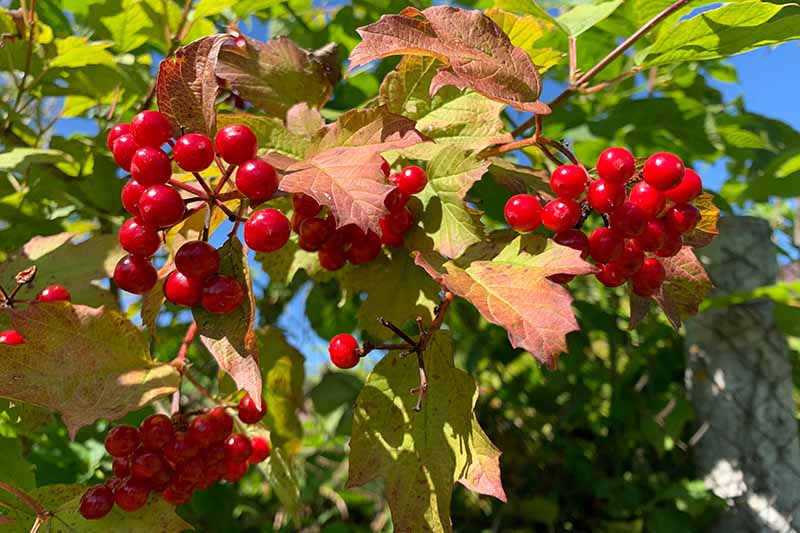
There is also a European cranberrybush, V. opulus, aka guelder rose, but it is considered invasive in the Midwest, so you may want to avoid it.
Some species, like the above-mentioned American cranberrybush, V. opulus ‘Americanum,’ have edible fruits that have long been enjoyed when cooked and made into jam.
This species is not to be confused with the food crop cranberry of Thanksgiving fame, Vaccinium macrocarpon. Read more in our guide to growing cranberries.
However, while there are edible ones, per the South Dakota State University Extension article, What is this Fruit, and is it Edible?, many viburnum fruits are “mildly poisonous,” and it can be difficult to distinguish between species without expertise.
We recommend cultivating viburnum for its ornamental landscape appeal, and do not advocate fruit consumption without expert guidance.
In addition to the varied fruits, there are foliar differences. Some species have closely packed leaves, while others have a loose and airy appearance.
The leaves are elliptical in shape. They may be glossy, smooth-edged, and evergreen, or dull, serrated, and deciduous. Some have hairy undersides, like downy arrowwood, V. rafinesquianum, a Midwest native.
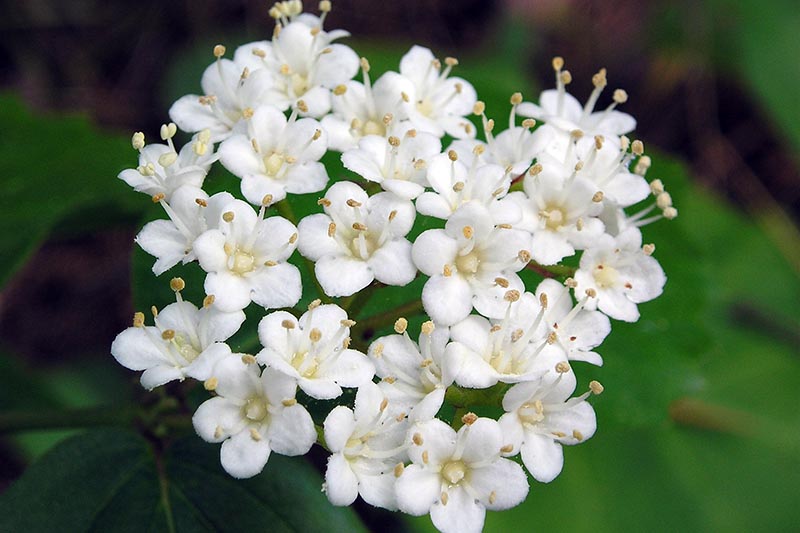
The flowers consist of rounded clusters of small blossoms called corymbs. They range in color from cream to pink or white, and many have a delightful spicy-sweet fragrance.
Another variable characteristic is the rate of growth. Some species, like non-native sandankwa viburnum, V. suspensum, grow faster than others, especially post-bloom in late spring to early summer.
Early evidence of viburnum includes the 5,300-year-old frozen remains of an Austrian hunter dubbed the “Otzi Iceman,” discovered in 1991 along with petrified arrows made from dogwood and viburnum.
In 1597, English herbalist John Gerard published “The Herball Or Generall Historie of Plantes,” in which he compared viburnum bark to that of a willow that bends but doesn’t break.
And in 1753, renowned Swedish botanist Charles Linnaeus first classified the genus in his work, “Species Plantarum.”
Early Native Americans used viburnum to make arrows, especially the straight, sturdy stems of arrowhead viburnum, V. dentatum, one of 15 species native to the eastern United States.
Today’s native and non-native species and cultivated varieties offer the home gardener a wealth of options for the landscape.
Viburnum Plant Propagation
While fruiting species do produce seeds, starting a bush this way is a very slow process, and only species plants rather than hybrids will replicate the traits of a parent plant.
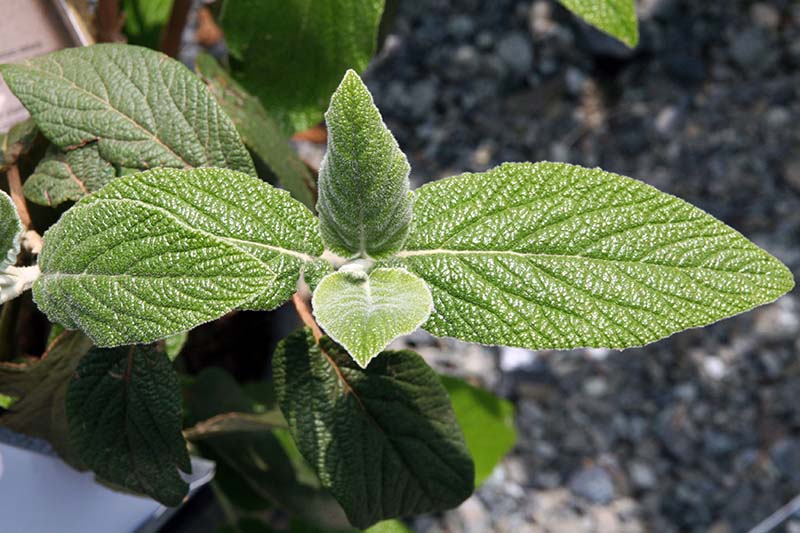
Better ways to begin are with a stem cutting from an existing plant, or a nursery transplant. Let’s look at each.
Stem Cuttings
There are two types of stem cuttings that may be used to propagate viburnum: hard and soft.
A hardwood cutting should be taken in late fall or winter, when the shrub is dormant.
Softwood cuttings are taken in late spring to early summer, soon after flowering, when the fresh flush of stem growth is still soft.
For both types, make a cut across a stem on a 45 degree angle, at a point that is four to six inches from the stem tip. Use sanitized pruners to make a cut that is swift and clean, leaving no ragged edges.
If it is spring and there are leaves present, remove these from the bottom three inches of the stem, leaving it bare.
Dip the cut end of the stem into rooting hormone powder and place it three inches deep in a well-draining container filled three-quarters full with a sterile potting medium.
Depending upon the weather, you should place the container in either a sheltered area of the garden, in a greenhouse, or indoors, in a sunny location.
Keep the potting medium moist, and the cutting will grow roots followed by fresh foliage.
Once new growth is evident, and there is no danger of frost, acclimate the cutting to the outdoors for a few hours each day.
Hardwood cuttings may be transplanted to the yard in the spring, and softwood cuttings can be hardened off and planted out in the summer.
At the time of transplant, prepare the ground and add fertilizer. This will be discussed in more detail in the upcoming growing section, so keep reading!
Nursery Transplant
A nursery transplant is a shrub that has been propagated in a nursery setting, and it’s ready for transplant upon purchase in either spring or fall. These are typically one or two years old, and come in a one- to two-gallon container.
When transplanting a shrub to the landscape, unpot it carefully, detangle the roots, and set the root ball into the ground per the instructions in the following section.
How to Grow Viburnum Shrubs
With such a wide array from which to choose, you’ll want to make sure you select bushes with mature dimensions that suit your space.
Choose a location with full sun to part shade. In the warmest regions, afternoon shade is beneficial. Some cultivars are more shade tolerant than others.
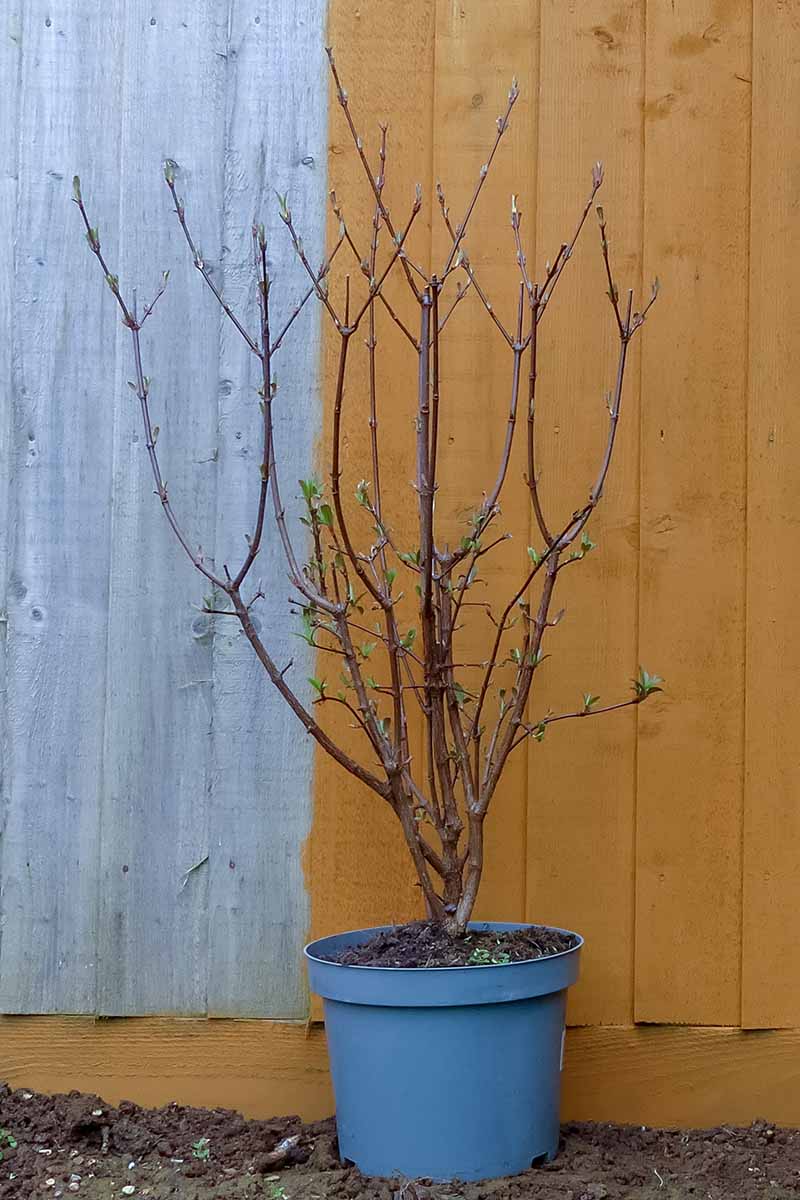
The ideal soil is organically-rich, moist loam that is slightly acidic, with a pH between 5.5 and 6.5. Provided it drains well, lower quality soil will do.
You can conduct a soil test to learn the characteristics of the earth in your landscape.
To enrich it and increase acidity, you can amend your soil with compost, leaf mulch, or aged manure. To sweeten overly acidic soil, you can add lime.
Work the soil until it’s crumbly, and make a hole that is twice as wide and twice as deep as the root ball of the shrub.
Some folks like to add an all-purpose, slow-release, balanced granular fertilizer to the planting hole per package instructions.
Avoid those that are heavy on the nitrogen in the NPK (or nitrogen, phosphorus, and potassium) mix, as it may cause too many leaves to form, and too few blooms.
Gently unpot the shrub and loosen any tightly bound roots with your fingers.
Settle the root ball in an upright position in the ground so that the crown, where the roots and stems meet, sits slightly above, or just at ground level.
Backfill the hole until the shrub is firmly fixed.
Water well, taking care not to wet the leaves, as this makes them prone to fungal disease.
If you haven’t already added fertilizer at this point, you can still do so.
Sprinkle granules of an all-purpose, well-balanced fertilizer in a ring around the shrub about ten inches out from the stems, making sure it doesn’t touch them.
Use the gentlest spray nozzle on your hose to lightly water in and activate the fertilizer granules.
A new shrub needs regular watering during the first growing season to establish strong roots. When the top inch of soil feels dry, pour a bucket of water over the root zone, unless it has rained one to two inches during the week.
If you aren’t sure how much rain you’ve received, you can use a rain gauge.
Reduce supplemental watering during wet weather, and increase it during dry spells.
You can even give your new shrub a bucket of water on a warmish winter day when the ground isn’t frozen.
Viburnum tolerates the juglone toxicity of black walnut trees, is not a favorite of deer, and exhibits above-average drought tolerance after the first year.
Remember that you have a wide variety of sizes and shapes from which to choose, ranging from two to 30 feet tall and two to 15 feet wide.
Space bushes to accommodate mature dimensions and allow airflow that inhibits moisture buildup and vulnerability to fungal disease.
For multi-shrub hedging, instead of allowing bushes to reach their mature dimensions without touching, plan for them to overlap with each other by about one to two feet at maturity.
Don’t plant them too close, or airflow will be severely limited.
You can also cultivate a small viburnum plant in a pot.
Choose a well-draining container with a depth of at least 18 inches and a diameter large enough to accommodate the mature width.
V. opulus ‘Nanum’ is an excellent candidate for container gardening, with a mature height and width of two to three feet.
Once planted and watered, apply a three-inch layer of mulch over the roots, but not touching the stems, to aid in moisture retention, inhibit weed growth, and keep the ground cool.
If you are cultivating a fruit-bearing bush, you’ll want to plant a similar, but not identical variety of the same species within 50 feet, to support cross-pollination and optimal fruiting.
Growing Tips
This is not a hard plant to grow when you remember the following:
- Know the mature dimensions of your selected variety and its preference for sun or shade before planting.
- Set the root ball at or slightly above ground level.
- Avoid nitrogen-heavy fertilizers.
- Water generously during the first year.
- Apply a layer of mulch for moisture retention, weed control, and ground cooling.
Pruning and Maintenance
Once your shrub is established, you won’t have to worry about providing supplemental water unless you experience a prolonged dry spell.
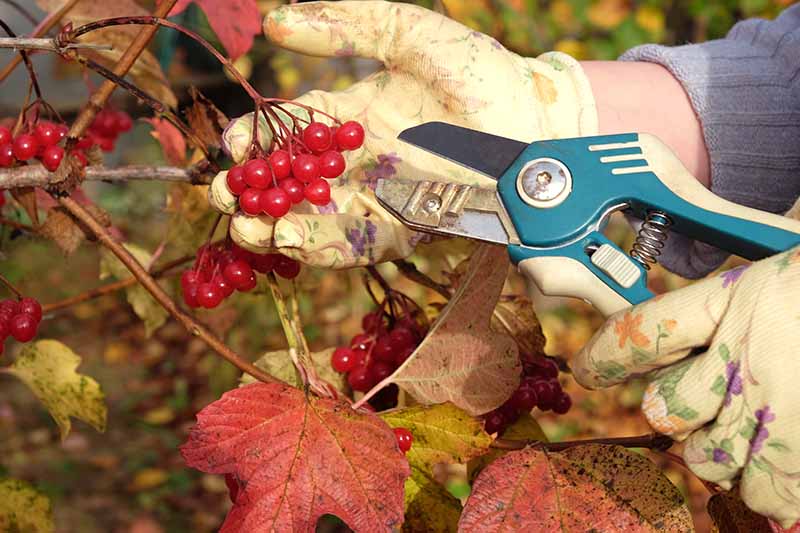
Each spring, just prior to budburst, apply the same all-purpose fertilizer you used at planting time. Sprinkle it in a circle about 10 inches out from the base. Fertilize again in late summer.
The best time to prune is just after blooming. Be sure to use sanitary, sharp equipment, and make clean cuts rather than ragged ones to promote rapid wound healing.
Remove broken, damaged, dead, diseased, infested, or rubbing branches.
Fast-growing varieties, such as Japanese sandankwa viburnum, V. suspensum, benefit from early season pruning to maintain a uniform shape, as do those grown as hedges or trees.
You may also want to thin out branches that are so dense they limit airflow, as this may lead to fungal development.
And if you are growing a species or cultivar with edible berries, you’ll want to use sanitary pruners to snip off ripe fruit clusters in late summer or early fall.
Viburnum Species and Cultivars to Select
There are so many types of viburnum from which to choose, it’s hard to know where to begin!
American Cranberrybush
As mentioned above, the American cranberrybush, V. opulus ‘Americanum,’ (formerly V. trilobum) bears edible red fruits that have been made into jams for generations.
Make sure you pick yours quickly, or the birds and wildlife will have a feast!
Its burgundy, orange, red, and yellow foliage enhance the understory of the fall landscape as the trees above change and annuals and perennials fade.
When winter has had its last blast, snowy white blossoms usher in spring.
Suitable for Zones 2 to 7, this type grows well in full sun to part shade. It tolerates wet soil well, and is often found in bogs in its native habitat.
Its growth rate is moderate, with an increase of 13 to 24 inches per year. Expect mature heights and widths between eight and 12 feet.
American cranberrybush is a good choice for informal hedging.
Find American cranberrybush plants now from Nature Hills Nursery.
Arrowwood
The arrowwood species, Viburnum dentatum, sports fall foliage in shades of yellow and red with striking bluish-black fruits.
Creamy flowers and lustrous serrated green foliage adorn this type in springtime.
Best suited to Zones 3 to 8, arrowwood thrives in full sun to part shade, where it reaches six to 15 feet tall and wide. Expect 13 to 24 inches of growth per year until it reaches its full stature.
Tolerant of clay soil, this dense shrub makes an imposing perimeter planting.
It is best known for having sturdy, straight stems once used for Native American arrows.
Find arrowwood viburnum now from Nature Hills Nursery.
Blackhaw
Blackhaw, Viburnum prunifolium, can tolerate part shade, but does best in full sun.
It is a large species that may be left to its own devices to produce multiple stems, or it may be pruned into a single-stemmed tree.
It grows best in Zones 3 to 9. Expect yearly increases of 12 to 24 inches during maturation. At maturity, heights range from 12 to 15 feet, and widths are between eight and 12 feet.
Blackhaw is a good choice for informal hedging, with its dense branches and irregular contours.
Find blackhaw now from Nature Hills Nursery.
These native species not only beautify the landscape, they provide essential habitat for endemic wildlife, birds, and beneficial pollinators as well.
Bodnant
Deciduous hybrid Bodnant, V. x bodnantense, has richly fragrant tubular pink blossoms.

It reaches heights of eight to 10 feet and widths of four to six feet. It is best suited to Zones 5 to 7.
Leatherleaf
Evergreen leatherleaf, V. rhytidophyllum, has thick-textured foliage, white blooms, and red fruits.
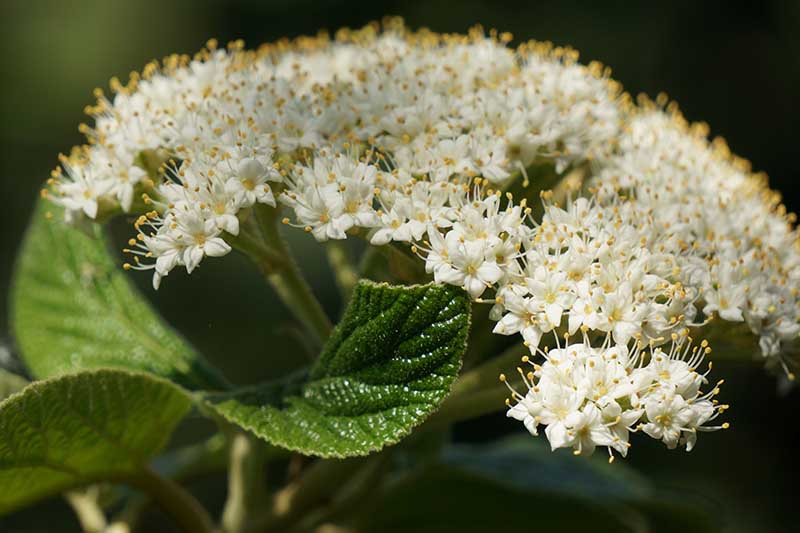
Its mature dimensions are six to 10 feet tall and wide. It grows best in Zones 5 to 8.
Mapleleaf
Mapleleaf, V. acerifolium, has white flowers that are somewhat smaller than those of other species.
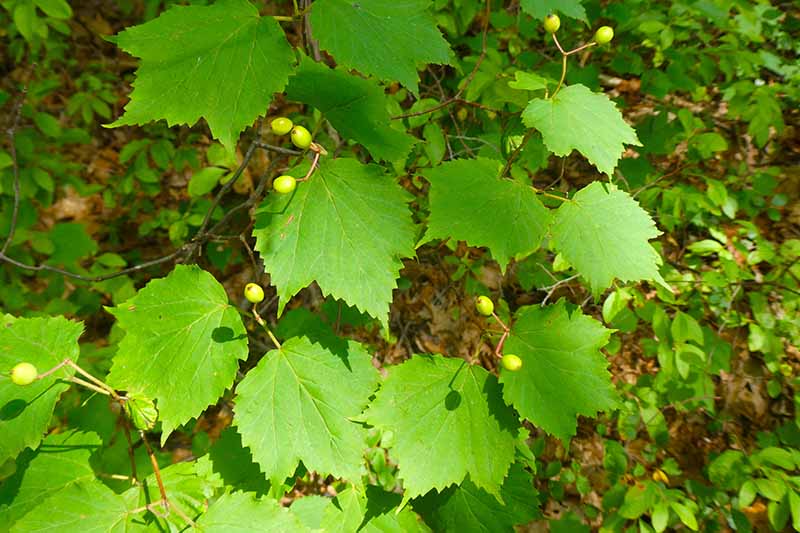
However, its claims to fame are maple-leaf-shaped foliage that shades to purplish-red in the fall, and clusters of deep blue fruits.
Mature dimensions are three to six feet tall and two to four feet wide, making it a candidate for a large container. It tolerates deep shade and dry soil, and thrives in Zones 3 to 8.
Nannyberry
Deciduous nannyberry, V. lentago, grows well in Zones 2 to 8. It has white blossoms in spring, and in fall, its most noteworthy feature is its long-lasting bluish black fruits.
This type is unique in that it can grow as a multi-stemmed bush with dimensions of 14 to 16 feet tall and six to 12 feet wide, or it may be pruned to grow as a single-stem tree reaching up to 30 feet tall.
And finally, remember that if you have one fruit-bearing bush, it’s best to plant a different variety of the same species within 50 feet, to ensure cross-pollination and ample fruit.
You can find bare root plants available from Nature Hills Nursery.
Want More Options?
Be sure to check out our guide, “25 of the Best Viburnum Varieties.”
Managing Pests and Disease
Unlike some plants, viburnum is not prone to pests or disease, and as mentioned, deer don’t generally favor it.
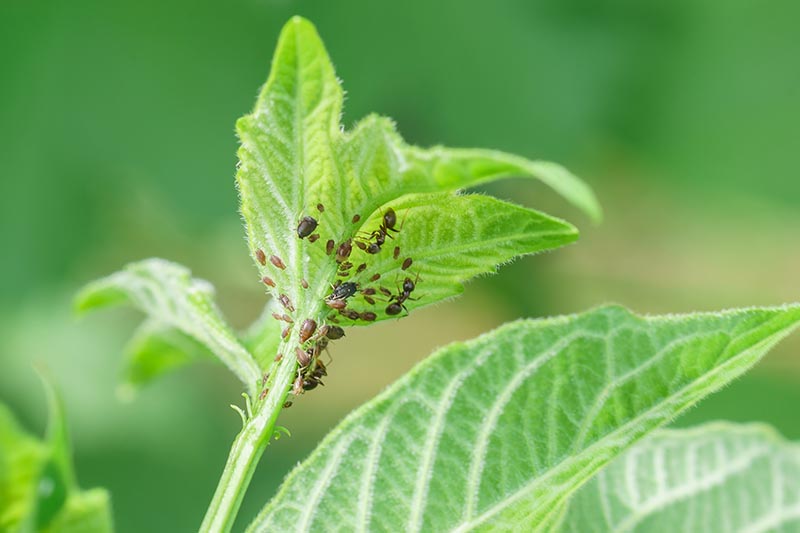
That being said, there are some pests and diseases to watch out for.
Common pests include:
- Aphids, Aphis fabae, Neoceruraphis viburnicola
- Root Weevils, aka Black Vine Weevils, Otiorhynchus sulcatus
- Southern Red Spider Mites, Oligonychus ilicis
- Thrips, Frankliniella spp.
- Viburnum Borers, Synanthedon viburni, S. fatifera
- Viburnum Leaf Beetles, Pyrrhalta viburni
- Viburnum Scale, Lichtensia viburni
Most of these are leaf and sap-feeding pests that may be treated with a firm spray of the hose, application of a horticultural oil, such as neem, or an insecticidal soap.
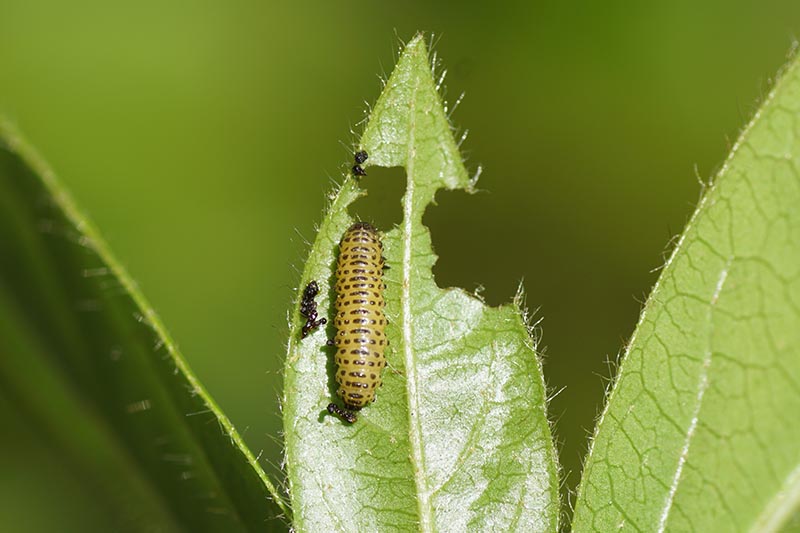
The root weevil and viburnum borer larvae may be eradicated with pyrethroid insecticides. The borer may also be addressed by trapping the winged adults before they reproduce.
Some diseases you may encounter are:
- Dieback and Canker, Botryosphaeria
- Downy Mildew, Plasmopara viburni
- Fungal Leaf Spot, Cercospora
- Powdery Mildew, Erysiphe viburni
- Root Rot, Armillaria
These are all fungal conditions that may be treated with appropriate fungicides. Note that some types of fungi may develop resistance if these products are not rotated.
Read more about identifying and treating common viburnum diseases.
While there are certain pests and diseases to be aware of, they may never pose a problem, especially if you remember to employ best garden practices, including:
- Purchasing good quality plants from reputable purveyors.
- Fertilizing for healthy growth.
- Spacing plants to accommodate mature dimensions and promote air circulation.
- Watering the soil over the roots, not the leaves.
- Keeping the immediate landscape area free of weeds that compete for water, and harbor bugs and pathogens.
- Pruning off all damaged and dead branches with clean, sharp pruners, to leave a clean “wound” that is less vulnerable to infestation and infection than a ragged one.
- Watering regularly, but avoiding over- and underwatering, to minimize moisture stress that increases susceptibility to pests and disease.
Best Uses for Viburnum Bushes
There are many landscape options with a varied and versatile shrub like viburnum.
Or, you may prefer to let a number of shrubs naturalize in proximity to one another for an informal hedge that affords privacy around a patio, or creates a barrier between properties.
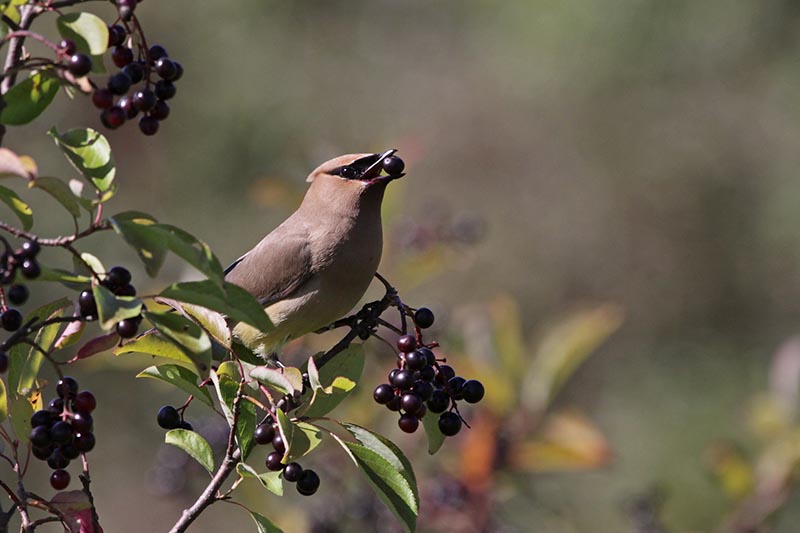
Smaller species and cultivars make excellent foundation plantings that soften the hard edges of buildings. Larger ones make excellent stand-alone specimens.
If you have a tree canopy and low-profile plantings, but nothing substantial growing in the mid-story region, viburnum may be the perfect “filler” between the shorter and taller trees, shrubs, and herbaceous plants in your landscape.
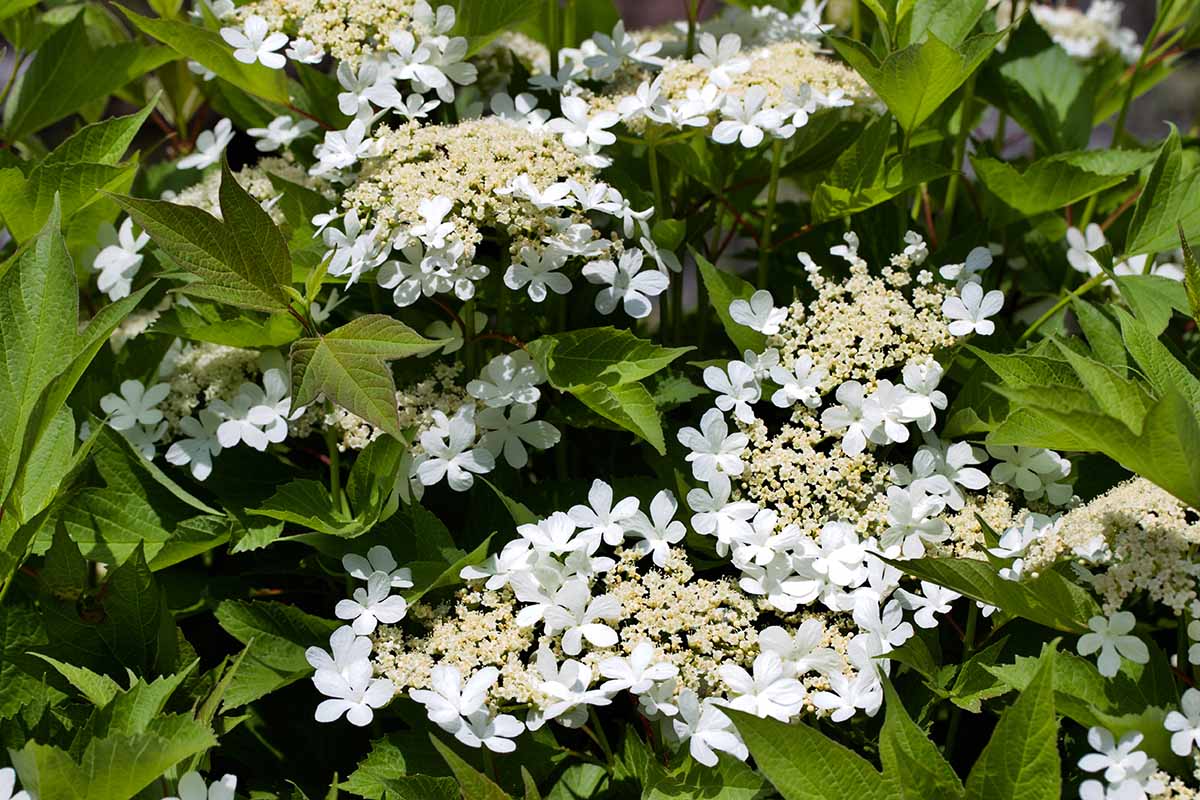
Try viburnum in a mixed grouping with plants of a similar growing culture, such as azalea, beautyberry, camellia, creeping phlox, hosta, hydrangea, or witch hazel.
Artistic options for growing viburnum include pruning it like a tree with a single trunk, by removing multiple foundation stems and removing the lower branches from the remaining leader.
For small-stature varieties, you may try your hand at cultivating a mini-tree in a pot, by selectively pruning off lower branches to achieve the appearance of a tree rose.
Quick Reference Growing Guide
| Plant Type: | Woody shrub | Flower / Foliage Color: | Cream, pink, white/green to orange, purple, red, yellow |
| Native to: | Central Asia, Europe, North Africa, North America | Tolerance: | Above average deer resistance, black walnut juglone, drought once established, poor but well-draining soil |
| Hardiness (USDA Zone): | 2-8 | Soil Type: | Organically-rich loam |
| Season: | Spring flowers, fall foliage/fruit | Soil pH: | 5.5-6.5 |
| Exposure: | Full sun to part shade | Soil Drainage: | Well-draining |
| Spacing: | 2-15 feet | Attracts: | Beneficial pollinators, birds, butterflies |
| Planting Depth: | Root ball even with or slightly above ground level | Companion Planting: | Azalea, beautyberry, camellia, creeping phlox, hosta, hydrangea, witch hazel |
| Growth Rate: | Moderate-fast | Uses: | Foundation planting, informal hedge, mass planting, mixed grouping, perimeter privacy, specimen, understory filler |
| Height: | 2-30 feet | Order: | Dipsacales |
| Spread: | 2-15 feet | Family: | Adoxaceae |
| Water Needs: | Medium | Genus: | Viburnum |
| Maintenance: | Low | Species: | Acerifolium, bodnantense, dentatum, opulus, obovatum, trilobum |
| Common Pests: | Aphids, root weevils, Southern spider mites, thrips, viburnum borers, viburnum leaf beetles, viburnum scale | Common Diseases: | Dieback and canker, fungal leaf spot, downy mildew, powdery mildew, root rot |
Four-Season Interest
Viburnum shrubs add year-round interest to the landscape, especially when you choose deciduous varieties that bear fruit and drop colorful leaves.
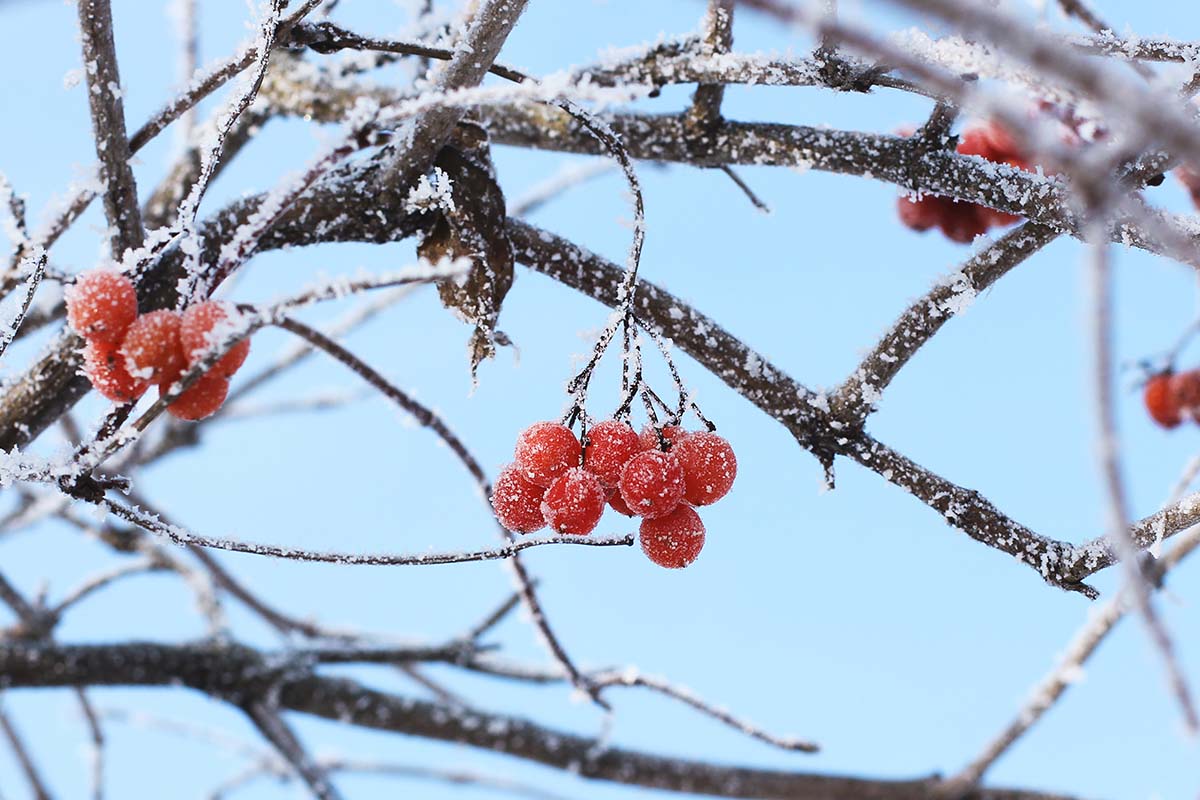
Fragrant blossoms usher in springtime, and lush green summer foliage is the perfect background for seasonal annuals and perennials.
Summer’s end brings colorful foliage and berries that may cling to the plants long into winter, adorning stark branches beneath a sugary dusting of snow.
If you’re in a warm growing zone, you can enjoy continuous lustrous evergreen foliage.
For an understory attraction that rewards growers with beauty, add viburnum to your garden planner. It is an easygoing shrub for all seasons.
If you found this guide informative, and would like to learn about more spring-flowering shrubs, we recommend the following:
